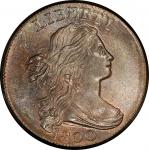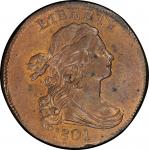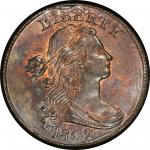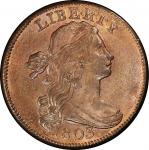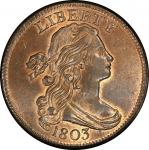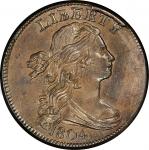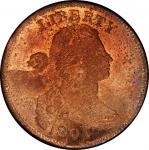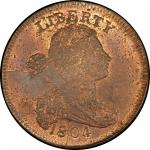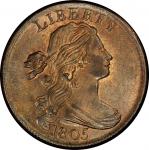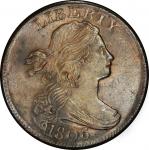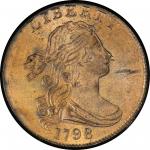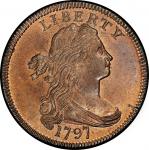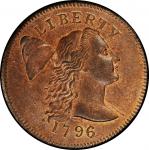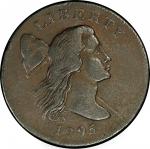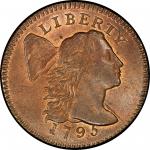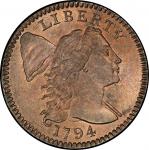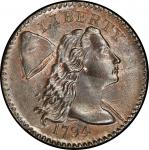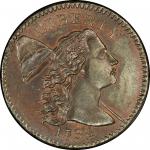1799年美分 PCGS MS 61。1799 Draped Bust Cent. Sheldon-189. Rarity-2+. Mint State-61 BN (PCGS). His record payment of $2,500 for the only known Uncirculated cent of 1799 brought him worldwide fame and letters from all corners of the earth. - C.L. Wallace, in his obituary of Henry C. Hines, The Numismatist, February 1947.Fully lustrous and uncommonly attractive for the assigned grade, this coin is a landmark: the finest known example of the most famous date rarity in the entire series of American cents. Steel brown surfaces show some medium brown highlights over the smooth, pleasing fields. The devices are sharp even as the typical peripheral softness of this variety is seen on the date and the top of the reverse. The wreath bow and leaf clusters right of it are likewise somewhat blunt, as is typical. The tips of denticles are seen from 12:00 to 5:00, framing the right side of the obverse, and longer denticles are visible around the reverse everywhere but the top of that side. A tiny natural planchet flaw was not fully obliterated left of the first S in STATES, and a related planchet fissure remains visible above the top leaf on the left side of the wreath. Only a few marks of consequence are seen, including a short dig at C of CENT, a nick below the left side of the nearby T, and a pinpoint contact point at the berry right of T. A thin hairline crosses below ATE of STATES and a few nearly invisible slide marks are seen on Libertys cheek.
Granting the Mint State status of this specimen and forgiving the usual soft strike of this date, there are few flaws that merit a numerical assignment so low within the Mint State continuum. The visual appeal is excellent.The dies are clashed, with the vestiges of the impression visible below Libertys hair bow and chin, and sharply in front of her profile. Two impressions are seen right of T in CENT, and the die chip or low spot between the top of that letter and the bottom of E in ONE is plain. This state is equivalent to Breens State II, a crisp early state.From the time of this coins discovery and for decades thereafter, this cent was the most famous cent in America, among both numismatists and the general public. It was discovered in England, in the trays of A.H. Baldwin and Sons, about 1928. A savvy but unidentified numismatist recognized its importance and brought it to Boston, where it was sold to longtime American Numismatic Association official Frank H. Shumway. In 1949, Shumway, then 73 years old but still active in Boston area numismatics, visited National Numismatic Collection curator and editor of The Numismatist, Stuart Mosher, and recounted the story of his role in this coins provenance. "It was he who first discovered the famous 1799 large cent that was later to sell for the sum of $2,500," Mosher reported in a column entitled "Odds and Ends" in The Numismatist of June 1949. Mr. Shumway got it in a trade in Boston, later sold it to Elmer Sears who in turn sold it to Henry C. Hines of Newark, New Jersey."Hines acquisition of the cent became a sensation. Though Hines had spent many tens of thousands of dollars on early cents, extending back decades into the 1880s, the record price of this coin brought him fame.
According to John W. Adams article on Henry Hines in the November 1979 issue of Penny-Wise, Hines payment of $2,500 to Wayte Raymond for the coin "would remain a record price for a large cent for more than a quarter of a century." Hines was proud to own the cent and proud of the attention it brought. When his copy of George H. Clapps The United States Cents of the Years 1798-1799 was sold by George Frederick Kolbe from the Stack Family Library in January 2010, "several newspaper clippings headlined Pays $2,500 for Penny And Calls It A Bargain or something similar" remained tipped in, having been saved by Hines for decades. One clipping, in German, was headlined "18,000 Schilling fur einen Groschen." Hines was particularly proud of the coins uniquely high grade, writing to either Homer K. Downing or Howard R. Newcomb in one letter "Even Mr. Elder admits my 1799 is at least Unc." Elder, of course, was the very definition of a curmudgeon. Praise from him was rare.Out of the many thousands of large cents and other coins owned by Henry C. Hines, this is the only one that was mentioned with uniformity in his various obituaries and memorials. He died on December 11, 1946, aged 90 years, 9 months, and 9 days. Memorials poured onto the pages of the numismatic press from all corners. The New York Numismatic Club, the esteemed society whose meetings Hines attended for decades, "stood for a moment of silence in his memory" at their gathering just two days after his death. Club Secretary Vernon L. Brown noted in the clubs report to The Numismatist "Mr. [Homer K.] Downing and others made a few remarks in regard to Mr. Hines collecting activities. He possessed the finest specimen of the 1799 cent."In Hines final years, his collection was dispersed in somewhat messy fashion. His longtime friend Carl Wurtzbach handled this coin and sold it to Dr. William H. Sheldon, who turned around and sold it to the enthusiastic and well-financed principals of the Sheraton Coin Company.
George H. Clapp told the story, insofar as he could, in an April 1947 letter to Wayte Raymond:"Dr. Sheldon, as I told you, started Sheratons and he claimed he had both of the 99s, which he bought from Carl Wurtzbach for $2,000.00 and Sheratons offered them at $2,000.00 each. It is difficult to straighten out the conflicting Hines stories."Despite the Sheraton firms exuberance, the late 1940s were a slow market, and they were unable to sell this prize. It was consigned with much of the rest of their inventory to the 1947 American Numismatic Association sale, the first to use the formula Dr. Sheldon devised to estimate value from a coins grade. While the mathematical relationship Sheldon derived worked for 1794 cents at a certain moment in time, it did not prove durable. This cents performance at the 1947 ANA auction well exceeded Sheldons predictions, which Sheldon explained away as the value of pedigree when discussing this coin in Early American Cents in 1949.Consider, for example, the famous 1799 from the Hines collection. This coin ... has a Book Value of $625. Yet on the only occasion when it has been sold publicly in this country (at the ANA Convention auction, 1947) it brought $1,500, and there were many who were ready to pay $1,000 for it. The coin has a pedigree value which probably doubles the book value.The fact that Sheldon sold the coin to the Sheraton Coin Company just a few years before at a price close to $2,000 was left unmentioned.By the time this cent was offered again a decade later, the market had rebounded and expanded.
Abe Kosoff promoted its appearance in the 1959 Dr. James O. Sloss sale as "The King of Cents," helping return the coin to the level of fame it had enjoyed when Hines acquired it 30 years earlier. When the auction had passed, Kosoff was able to release an exuberant press release that celebrated a new record.The crowd grew expectant as the unprecedented offering of 1799 cents was at hand ... Lot 50, the highlight of the sale, the King of Cents, the Hines 1799 perfect date. This, the most famous and most desirable of the large coppers, is head and shoulders superior to any other specimen. This remarkable combination of rarity, pedigree and condition smashed the record set by the 1793 Crosby 1-C earlier in the evening.The coin realized the extraordinary sum of $10,500 and disappeared into Ted Naftzgers legendary collection. It would not sell at auction again for a full half-century, until 2009, when D. Brent Pogue acquired it. Over that interval, the Lord St. Oswald cents reminded American collectors of the treasures that awaited in England, where this coin first surfaced. Air travel made exploring the world for high grade American coins easier, and the American coin market grew strong enough that millions of dollars of old numismatic holdings were lured into the open to thrill a new generation of collectors. Hundreds, perhaps thousands, of new high grade cents were discovered, in dusty cabinets, in forgotten museum collections, or overseas. But no one ever located a better 1799 cent than this one.The key position the 1799 cent occupies within large cent collecting parallels the outsized role large cents have played in American numismatics as a whole. By the 1840s, Joseph J. Mickley had determined that this cent was rare above all others, yet after decades as the most famous numismatist in America, he never saw one this fine.This is the only Mint State 1799 cent certified by PCGS, the single finest example of this date identified despite being central to American coin collecting since before the Civil War. Its fame, quality, and importance have no peers within the broad realm of early American copper coins.


